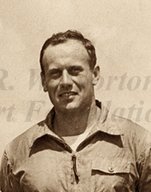
|

|
|
|
|
He was born in Springfield, Missouri. In 1935 his father moved to Cabool, Misouri, and opened a drugstore. There, Orvis got his first "air ride" from the famous barnstormer, Wiley Post. He graduated from high school in 1940, and attended Drury College. One Sunday while in college he emerged from a movie theater to hear the news about Pearl Harbor. He recalls the reaction of his classmates. "They said, `I want to go to war. I'm ready to go. Let's go. What do we do?'" he recalls. "In my class at Drury all but two men went in the service, and those two didn't go because they couldn't get in." Orvis selected the U.S. Navy aviation. He learned to dive-bomb in the SB2C Curtiss Helldiver, an aircraft he rates as "slow and kind of like a truck." It was also called the "Gooney Bird." Orvis flew off the USS Bennington (CV-20), an aircraft carrier from which he struck the Japanese battleship, Nagato, on his first mission. He scored a hit and received an air medal. Orvis also served as spotter for American battleships firing on Hokkaido--the first bombardment of the Japanese homeland. In all, he flew ten strikes, mainly against shipping or munitions plants in ports. He reports that his squadron lost three men, all to anti-aircraft fire. The day after Japan surrendered the Bennington sailed into Yokohama where Orvis went ashore. "They were courteous, they bowed, and they really treated us fine," he says of the Japanese people. "It was almost the same as if you'd been there in peacetime." He returned home in December of 1945, graduated from Southwest Missouri State in Springfield in 1948, and went into coaching. Hired at West Point, he worked as an assistant under the legendary football coach, Earl "Red" Blaik. After four years he was hired at Centenary College as basketball coach and athletics director. He remained there stayed until 1973, and then entered the sporting goods business and advertising before retiring. |


